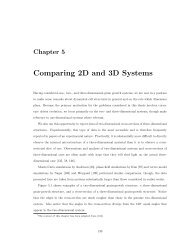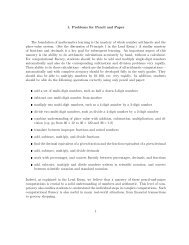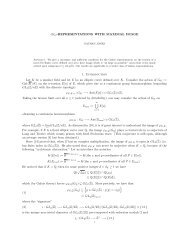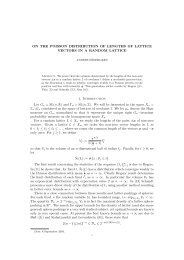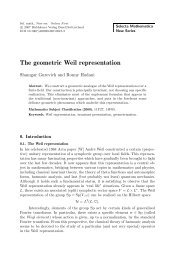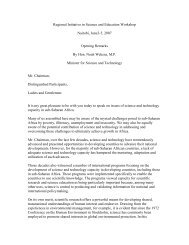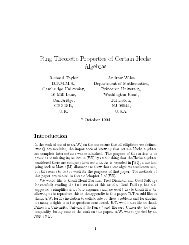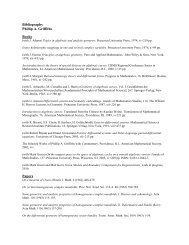You also want an ePaper? Increase the reach of your titles
YUMPU automatically turns print PDFs into web optimized ePapers that Google loves.
2 MAKSYM RADZIWI̷L̷L<br />
there is some care necessary in defining what it means <strong>to</strong> have “B(f; x) 2 random variables”.<br />
For this reason we first illustrate our results in the special case of the Poisson distribution.<br />
Following the work of Selberg [11] and Sathe [10] (in the case g(p) = 1) and Halasz [4]<br />
(in the general case g(p) ∈ {0, 1}), it is known that if g is a strongly additive function with<br />
g(p) ∈ {0, 1} and B(g; x) → ∞, then<br />
(3)<br />
{<br />
1<br />
x · # n x :<br />
g(n) − µ(g; x)<br />
B(g; x)<br />
uniformly in 1 ∆ o(B(g; x)), where,<br />
Poisson (λ, ∆) :=<br />
}<br />
∆ ∼ Poisson ( B(g; x) 2 ; ∆ )<br />
∑<br />
vλ+ √ λ∆<br />
e −λ · λv<br />
v!<br />
denotes the tail of a Poisson distribution with parameter λ. It is not difficult <strong>to</strong> see that the<br />
condition g(p) ∈ {0, 1} is not strictly necessary for the validity of (3) (for example one could<br />
let g(2) = 10 and (3) would still hold). Indeed, a minor variation on Halasz’s <strong>theorem</strong> [4]<br />
shows that <strong>to</strong> guarantee (3) it is enough <strong>to</strong> have 0 g(p) O(1), B(g; x) → ∞ and<br />
1 ∑<br />
( )<br />
g(p) 2<br />
1<br />
(4)<br />
= δ<br />
B(g; x) 2<br />
1 (t) + O<br />
p<br />
B(g; x) 2<br />
p x<br />
g(p) t<br />
as x → ∞, uniformly in t ∈ R, and where<br />
⎧<br />
⎪⎨ 0 if t < α<br />
1<br />
(5) δ α (t) := if t = α<br />
2<br />
⎪⎩<br />
1 if t > α<br />
Relation (4) roughly asserts that for most primes p, g(p) = o(1) or g(p) = 1 + o(1). It turns<br />
out that a condition such as (4) (perhaps with a weaker error term) is not only sufficient for<br />
(3) but also necessary. This is a special case of our main result (Theorem 2).<br />
Theorem 1. Let g be a strongly additive function. If (3) holds uniformly in 1 ∆ ≪<br />
B(g; x) 1−ε , then, as x → ∞,<br />
1 ∑ g(p) 2<br />
−→ δ<br />
B(g; x) 2<br />
1 (t).<br />
p<br />
for all t ≠ 1.<br />
p x<br />
g(p) t<br />
Both Theorem 1 and the sufficient condition (4) are special cases of more general results<br />
which we will now state. Our proofs build in a fundamental way on Halasz’s paper [4] and<br />
its application <strong>to</strong> large deviations of additive functions developed by Halasz (unpublished,<br />
see [2]) and the Lithuanian school (for example [8]). The main <strong>to</strong>ol underneath these large<br />
deviations results is Cramer’s method [1], first transposed in<strong>to</strong> an arithmetic context by<br />
Kubilius, in [7].<br />
Despite being more technical our main result (Theorem 2 and Theorem 3) has the merit<br />
of making clear the inter-relation between the distribution of the additive function on the<br />
integers and its distribution on the primes. This inter-relation by Levy Processes (in fact a<br />
modified version of that concept) which we now introduce in<strong>to</strong> our discussion.



